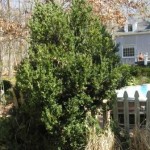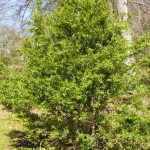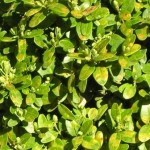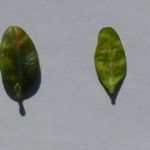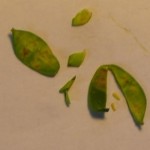Boxwood come in many shapes and sizes. There are many cultivar of boxwood though
mostly I see the American boxwood and the English boxwood. The American boxwood is simply the regeneration of the plant by seed where as an English boxwood is the regeneration of a cultivar by rooting a clipping from the selected plant. I have been given an odd boxwood dubbed the Weeping boxwood which has done very well and is an extremely fast grower, about a foot per year. One can generally tell the difference between an American, English and Weeping boxwoods by the shape and structure. The English is a dense slow growing shrub with smaller leaves than the American. The American grows faster and has an open sparse branch
structure being more pinical in shape when young. The Weeping boxwood is very fast growing, so much so that in the spring it weeps over with new growth. The Weeping boxwood is even
more sparse in structure and pinical in shape. Boxwood thrive in shade and scattered sunlight. They can tolerate full sun and dense shade. Unlike many woody stem plants in Virginia, boxwoods prefer a less acidic soil and do well in manicured lawn
spaces where lime is employed. Boxwood roots are shallow and need plenty of mulch and protection from draught conditions. Watering is a priority to establishing boxwoods of all sizes. They are relatively easy to root and transplant as long as they don’t dry out. There are a few diseases to be concerned about. In most cases early detection and mechanical treatment or pruning can be the remedy. One obvious pest
visable this time of year (April) is the leaf minor. A close inspection of the under side of an infected leaf when split open reveals the
troublesome grub. Two years ago I discovered an infestation of these insects in some American boxwoods. I pruned back the
infected limbs before the grub emerged. Now the plants are thriving with no signs of leaf minors and no harmful chemicals having been applied.

